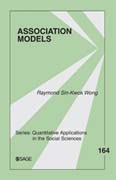
Many social science data are by nature organized in cross-classified formats,for example, gender and racial differences in the relationship between education and occupation, cross-national and/or temporal changes in patterns of marriage homogamy, temporal variations in import/export or input/output patterns, changes in the relationship between class positions, party identification and voting, and changes in the characteristics of urban neighborhoods in the United States over time. While the substantive rationale in exploring their systematic relationship may appear simple and straightforward, the application of appropriate statistical tools to decipher and interpret the meaning and complexities of the relationships involved can sometimes be difficult. Fortunately, with the important pioneering works in this field we now have a large repertoire of statistical models, association models in particular, which are well-suitedfor such analyses. Although association models have been widely utilized by social stratification researchers, especially in the study of social mobility and assortative mating such techniques have yet to be widely disseminated to other social science disciplines. This is partly because most of the important contributions are scattered in various journals and there has not been any systematic effort to integrate the family of association models into a single, coherent framework. INDICE: Introduction / Association Models in Two-Way Tables / Partial Association Models for Three-Way Tables / Conditional Association Modesl for Three-Way Tabels / Practical Applications of Association Models / Conclusion
- ISBN: 978-1-4129-6887-4
- Editorial: Sage
- Encuadernacion: Rústica
- Páginas: 184
- Fecha Publicación: 30/04/2010
- Nº Volúmenes: 1
- Idioma: Inglés
